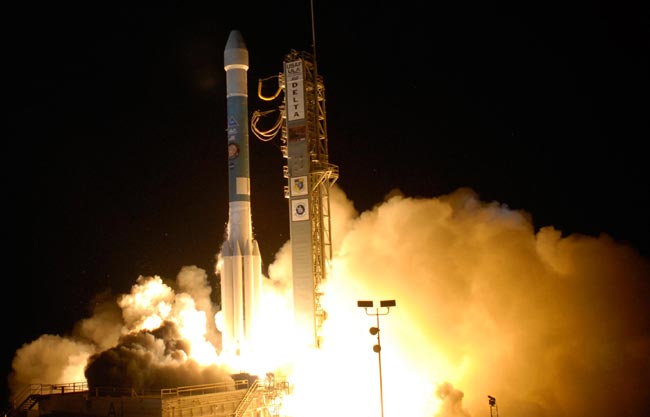NASA's Phoenix Mars Lander in Good Health After Launch

CAPE CANAVERAL, Fla. — A NASA probe bound to dig into the icy Arctic Circle of Mars is in good health after a picturesque predawn launch, mission managers said Saturday.
The Phoenix Mars Lander is precisely on target for its 422 million-mile (679 million-kilometer) trip to the red planet following an early morning liftoff today from the Cape Canaveral Air Force Station.
"We have a happy spacecraft," said Ed Sedivy, spacecraft program manager for Phoenix's builder Lockheed Martin, during a post-launch briefing here at NASA's Kennedy Space Center, adding that telemetry from the probe was spot on. "At that moment, everybody knew that it was the homerun that they were looking for."
A United Launch Alliance Delta 2 rocket blasted Phoenix into space at 5:26:34 a.m. EDT (0926:34 GMT), leaving a ghostly contrail of exhaust as the spacecraft left Earth behind. The lander is due to land on the flat arctic plains near Mars' north pole on May 25, 2008.
"It was the most beautiful thing I've seen," said Phoenix principal investigator Peter Smith, of the University of Arizona, of the liftoff. "This cloud turned into what looked like wings and a beak and a long tail and looked amazingly just like a phoenix bird, the message to me was: Phoenix bird has risen! And it has. We're on our way to Mars."
Phoenix is now speeding through space at about 12,300 miles per hour (19,794 kph) — almost its top speed — relative to Earth, and should pass beyond the moon's orbit by about 3:00 p.m. EDT (1900 GMT) this afternoon, mission managers said.
The 772-pound (350-kilogram) spacecraft's launch was so precise that Phoenix was able to conserve about 22 pounds (10 kilograms) of precious propellant, which will add some maneuvering flexibility once the probe prepares for its Mars descent next year.
Breaking space news, the latest updates on rocket launches, skywatching events and more!
NASA's $420 million Phoenix mission is aimed at an icy, flat region of northern Mars known as Vastitas Borealis. There, the lander is expected to use its eight-foot (2.4-meter) robotic arm like a backhoe to carve out samples of the surrounding martian soil and ice. The samples will be analyzed by onboard ovens, cameras, microscopes and a wet chemistry laboratory to determine their chemical makeup.
Researchers are hoping to learn whether the icy terrain has preserved any organic molecules or compounds within the martian soil, which may prove useful in determining whether the area may have once been habitable for microbial life. Phoenix also carries a laser ranging and detection tool and other instruments mounted to a meteorology mast to study the arctic weather on Mars.
Much of Phoenix's structure and seven-suite science package were developed for or recycled from NASA's canceled Mars Surveyor 2001 Lander and the ill-fated Mars Polar Lander, which was lost during its 1999 descent to the martian surface. Phoenix scientists hope their probe will recover some science lost from the 1999 mission's failure.
"It's a great day for America, it's a great day to continue exploration," NASA's Mars program director Doug McCuistion said after the successful Saturday launch.
SPACE.com Staff Writer Dave Mosher reported from Cape Canaveral, Florida. Staff Writer Tariq Malik reported from New York City.

Tariq is the award-winning Editor-in-Chief of Space.com and joined the team in 2001. He covers human spaceflight, as well as skywatching and entertainment. He became Space.com's Editor-in-Chief in 2019. Before joining Space.com, Tariq was a staff reporter for The Los Angeles Times covering education and city beats in La Habra, Fullerton and Huntington Beach. He's a recipient of the 2022 Harry Kolcum Award for excellence in space reporting and the 2025 Space Pioneer Award from the National Space Society. He is an Eagle Scout and Space Camp alum with journalism degrees from the USC and NYU. You can find Tariq at Space.com and as the co-host to the This Week In Space podcast on the TWiT network. To see his latest project, you can follow Tariq on Twitter @tariqjmalik.
